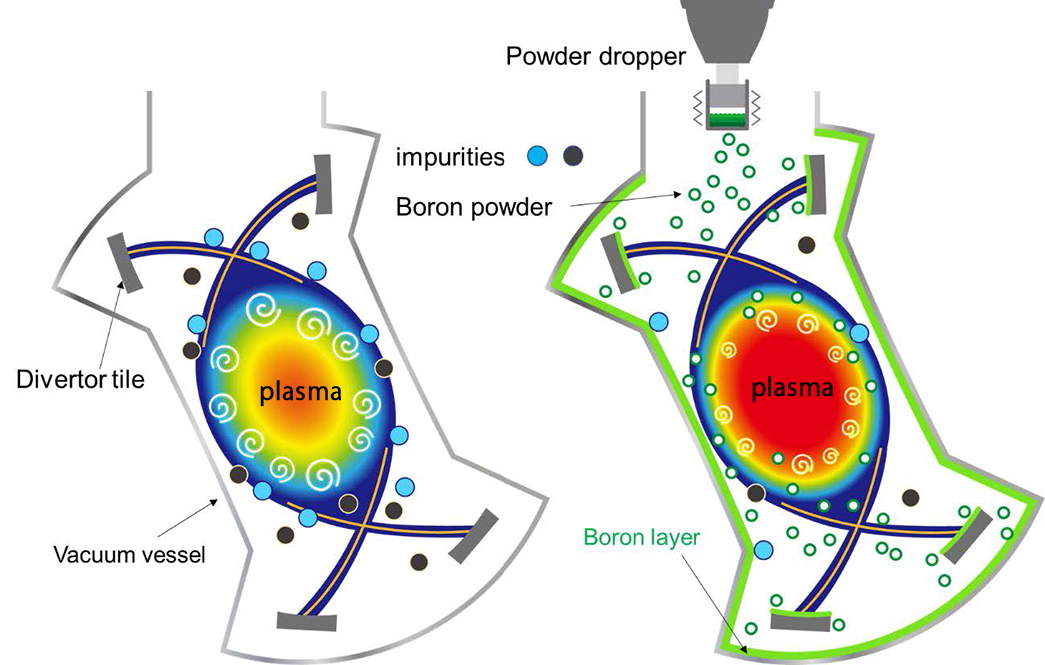Boron powder injection makes plasma temperature increase
─Both impurities and turbulence are suppressed simultaneously in a discharge─
In order to realize a fusion power reactor, it is necessary to maintain a high temperature plasma. For the maintenance, impurities generated from the vessel walls and turbulence generated in the plasma, which can cause large energy loss, should be suppressed. An international collaboration research team of Doctor Federico Nespoli at the Princeton Plasma Physics Laboratory, Professor Suguru Masuzaki at the National Institute for Fusion Science and their colleagues performed an experiment of injecting tiny grains of boron powder into plasma in the Large Helical Device (LHD). They found that the boron powder injection could reduce both impurities from the wall and turbulence in the plasma. This result will greatly contribute to the establishment of a method to stably maintain a high temperature plasma.

In order to realize a fusion power reactor, it is necessary to confine deuterium-tritium mixture plasma by using a strong magnetic field, heat it to a temperature of over 100 million degrees Celsius, and maintain it stably. However, when impurities such as oxygen generated from the vessel wall enter the plasma, the plasma temperature decreases, due to heat loss from the plasma. In addition, turbulence, which is a flow with vortices of various sizes, is generated in a high-temperature plasma, can cause plasma heat loss by enhancing particle and energy transport. To maintain a high-temperature plasma, we must establish a method to suppress such heat losses. If both the impurities and the turbulence can be suppressed simultaneously by the same method, it will be a very promising way to maintain a high temperature plasma.
One way to reduce the heat loss, due to impurities from the walls, is to coat the walls with boron. At the Large Helical Device (LHD) of the National Institute for Fusion Science (NIFS), the walls are coated with boron before the start of each year's experimental campaign. However, once the experiment begins, it is difficult to apply a new boron coating on the walls because the usual boron coating is conducted in a glow discharge without magnetic field.
In an international collaboration with the Princeton Plasma Physics Laboratory (PPPL) in the United States, NIFS has installed a device on the LHD for injecting controlled amounts of submillimeter powder grains into the plasma, under the action of gravity. The installation of this device has made it possible to make a new boron coating on the walls in real time by injecting boron powder in the plasma, while conducting LHD plasma experiments. As a result, it was observed that the impurities from the wall were reduced, and the plasma temperature increased.
Furthermore, the international collaboration research team of Doctor Federico Nespoli at PPPL, Professor Suguru Masuzaki at NIFS, and their colleagues found that while injecting boron powder into the plasma, heat loss from the plasma was suppressed and plasma temperature became higher than that before the injection, and the good state sustained stably during the injection. This could not be explained only by the reduction of impurities from the walls.
In order to clarify the reason why such a good state could be maintained stably, the research team measured the plasma state in detail using advanced measurement techniques. They then analyzed the newly obtained measurement data and the numerous accumulated data that had been obtained by experiments and computer simulations. As a result, it was found that the injection of boron powder suppressed turbulence generated in the plasma. In other words, the research team has found that by injecting boron powder into the plasma, we can suppress both impurities from the walls and turbulence in the plasma simultaneously, and can suppress heat losses from the plasma.
The research team has shown a way to suppress impurities from the wall and turbulence in the plasma in real time. In a future fusion reactor, it will be necessary to suppress plasma temperature decrease during operation. The result of this study will make a significant contribution to the establishment of such a method.
This research result was published on January 10, 2022 in Nature Physics, an international journal on physics.
